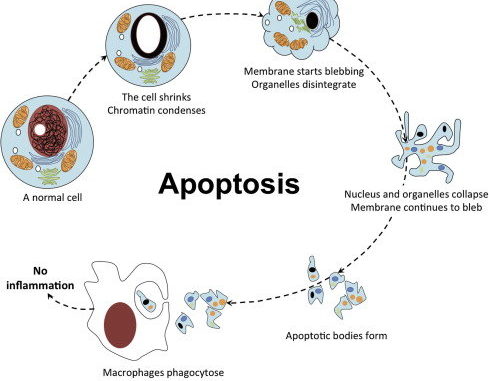
Cell death :
- One of the weirdest fate of the cell is the programmed cell death. Despite being odd fate it is essential for the body.
- Cell death has its own significance as such that it prevents our hands from being webbed, our embryonic tails from being prominent, our immune system from responding to our own proteins, and our brain from being jumbled with useless electrical connections.
- As a fact, the majority of cells produced in course of brain development also die during development.
- Cell death is regulated by cellular interactions in two fundamentally distinct ways.
- First, majority of the cells, if not all, in multicellular organisms need signals to remain alive.
– In case if such survival signals, frequently referred to as trophic factors, are lacking, cells activate a “suicide” program. - Secondly, in some developmental conditions, including the immune system, specific signals produce a “murder” program that kills cells.
- Recent studies suggest that whether cells commit suicide for absence of survival signals or are murdered by killing signals from other cells, death is mediated by a common molecular pathway.
Programmed Cell Death Occurs Through Apoptosis:
- The occurrence of cell death in programmed way is marked by a well-defined sequence of morphological changes, collectively termed as apoptosis.
- Apoptosis is a Greek word that refers “dropping off” or “falling off,” as in leaves from a tree.
- Dying cells at first shrink and condense and then fragment, releasing small membrane-bound apoptotic bodies.
- These apoptotic bodies are generally engulfed by other cells, such as macrophages. The nuclei condense and the DNA is fragmented.
- Also, a lipid molecule termed as phosphatidylserine is displayed by the fragments of dying cells. This permits the other phagocytic cells to bind and eat the fragments.
- Significantly, the intracellular constituents are not released into the extracellular milieu to prevent the deleterious effects on neighbouring cells. Thus, it is also termed as the tidy way of cell death.
- The highly stereotyped changes accompanying apoptosis suggested to early workers that this type of cell death was under the control of a strict program.
- This program is crucial during both embryonic and adult life for the maintenance of normal cell number and composition.
Role of genes in apoptosis:
The genes involved in controlling cell death encode proteins with three different functions:
- “Killer” proteins are required for a cell to begin the apoptotic process.
- “Destruction” proteins are responsible for things like digesting DNA in a dying cell.
- “Engulfment” proteins are needed for phagocytosis of the dying cell by another cell.
- At first glance, engulfment seems to be simply an after-death clean-up process, but some evidence suggests that it is part of the final death decision.
- For example, mutations in killer genes always prevent cells from initiating apoptosis, whereas mutations that block engulfment sometimes allow cells to survive that would normally die.
- That is, cells with engulfment- gene mutations can initiate apoptosis but then sometimes recover.
- In contrast to apoptosis, cells that die in response to tissue damage manifest different morphological changes, termed as necrosis.
- Necrosis is typically a messy way of cell death i.e. during cell death, cells leak out the contents to extracellular environment.
- When the toxic chemicals come in contact to cell or if any injury occurs, the cell’s plasma membrane will now be fragile. It will be unable to regulate the flow of ions and water thus resulting in swelling up of cells.
- Typically, cells that undergo this process swell and burst, releasing their intracellular contents that can damage surrounding cells and frequently cause inflammation.
- Apoptosis is useful for the elimination of various cancerous or infected cells.
- It will detect the threats arising from the viral infections, DNA damage, precancerous cells and will eliminate them.
- The development and regulation of immune system is also performed by apoptosis.
- B and T cells are first tested if they respond to any of body’s own cell components. If they do so, they are eliminated right away by the apoptosis.
- For the maintenance of immune system, apoptosis has a significant role.
- When a pathogen enters the body, various immune cells specific to the pathogen divide largely and fight the pathogen.
- After combatting the pathogen, those immune cells are now not required and thus under apoptosis so as to maintain balance in immune system.
